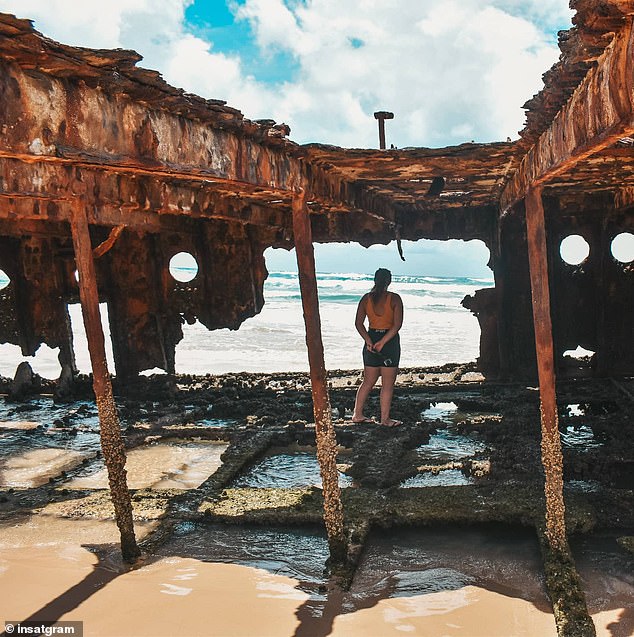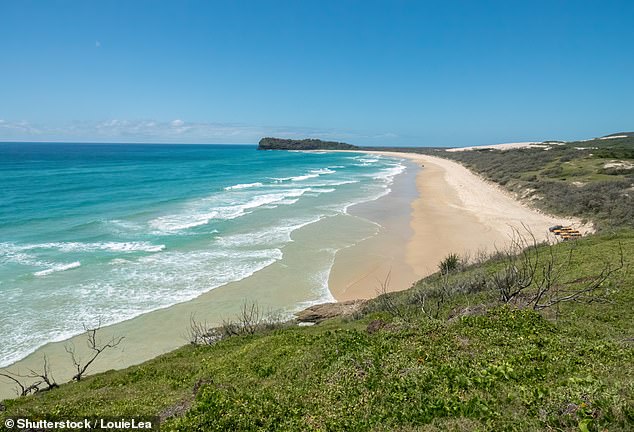K’gari tourists slammed as ‘ignorant’ for flouting rules about SS Maheno shipwreck at popular Queensland destination
Tourists visiting a popular Australian destination are being criticized for their “ignorant” behavior around one of the island’s Instagram-famous attractions.
Formerly known as Fraser Island, K’gari is a World Heritage Site along the south east coast of Queensland and is part of the Great Sandy National Park – famous for its long beaches, forests and pristine freshwater lakes.
The island is also home to a tourist attraction: the metal shell of the SS Maheno, which was wrecked on the island during a cyclone in 1935.
Travelers flock to the rusty remains to take evocative, moody photos inside the shipwreck, despite a “large” danger sign warning tourists to stay at least ten feet away from the “deteriorating” ship.
A man who regularly takes visitors to the island labels tourists who flout the rules as ‘ignorant’ and ‘entitled’.
Many tourists climb onto the rusty remains of the SS Maheno at K’gari (pictured) to get their pictures taken, despite large ‘danger’ signs warning people to stay three meters away from the wreck

A large ‘danger’ sign warns visitors that ‘unauthorized access’ to the shipwreck is ‘prohibited’, with fines of up to $7,740 for those caught breaking the rules
“I regularly witness tourists touching and climbing the wreckage, even after reading the sign or being informed,” the man said. Yahoo News.
“It seems to be a common problem on the island where visitors feel they are allowed to do whatever they want because they have paid for a permit to visit so they can do whatever they want.
The same goes for the rules about the dingoes, and most if not all of the latest attacks can be traced back to unwitting tourists.’
A large sign at the shipwreck warns visitors of ‘unauthorized entry prohibited’ to those wishing to enter the hull of the boat.
“The shipwreck remains are collapsing,” the sign reads.
Sharp, rusty metal is hidden in the surrounding sand. Rising waves and metal fragments pose a serious health risk to visitors.
Serious injury or death could result from attempting to get close to the wreckage ruins. For your safety, stay behind. Take your pictures and leave carefully.’
The man, who wished to remain anonymous, shared a reminder of the rules on Facebook, along with a photo of the ‘danger’ sign.
“I’m posting this because of the amount of people I see in and on the Maheno shipwreck,” he wrote.
‘Indian Head used to have a similar sign for the headland, which had a fine of 80 fines. Tourists ignored the rules and are now complaining that the headland is now closed.
“If you want to blame anyone, it’s not QPWS (Queensland Parks and Wildlife Service), the Butchulla or the name change to K’gari, it’s the tourists who don’t give a damn and do what they want. What will happen to our country?’

Tourists are accused of flouting rules to take a picture with the wreck (pictured)

Rangers on the island take an ‘educational approach by issuing verbal warnings’ to those who break the ten-foot rule
However, the man’s post angered tourists, calling him a “Karen” and claiming they would do whatever they wanted.
“I’m just sick of the nanny state,” one wrote.
“I go in and enter the wreck whenever I want, it’s on a public beach.” another person commented.
A third said, “I get a little over it when someone tells me I can’t do something, while I’m sitting in an office that has no life experience and is wrapped in bubble wrap.
“I’m not saying I want people to get hurt, but shouldn’t it be our choice of what we consider dangerous based on our life experiences.”
Others argued that “people are responsible for their own actions” and that the government is “just trying to take advantage of the citizens.”
Many defended the rules surrounding the heritage-listed site, claiming the sign reminded people to safely enjoy the attraction.
“Unfortunately, if they didn’t warn you, a goose gets hurt and a chasing paramedic lawyer the goose gets a payout because they weren’t warned,” one person commented.
“I mean, if you want a hundred-year-old, rusty piece of steel through your foot that you can’t see through the soft sand, by all means enjoy the public beach.” another wrote.
The Department of Environment and Science told Daily Mail Australia that visitors ignoring the sign risk a maximum fine of 50 units, which equates to a fine of $7,740.

K’gari, formerly known as Fraser Island, is a World Heritage Site along Queensland’s southeast coast and is part of the Great Sandy National Park, famous for its long beaches, forests and pristine freshwater lakes (pictured)
The department explained that the three-meter rule was introduced to preserve Maheno’s historic value and protect the safety of visitors.
“Due to the historical value of the Maheno and the deteriorating condition of the shipwreck, access to the wreck or within 3 meters of any part of the wreck is prohibited,” the Ministry of Environment and Science said.
“This is to protect the wreck and visitors. Walking on or around the wreck could result in serious injury or death.
“The wreck above the sand is crumbling, rusting steel and people can fall through the structure. Much of the wreckage is buried under the sand – and people have been known to cut their feet and legs on sharp, rusty steel.”
The department added that visitors to the island put personal safety above their “desire to take selfies,” despite signs warning them not to climb, touch or go near the wreck.
While rangers “generally take an educational approach by issuing verbal warnings,” they can also hand out a $464.40 fine to anyone violating the three-foot rule.
